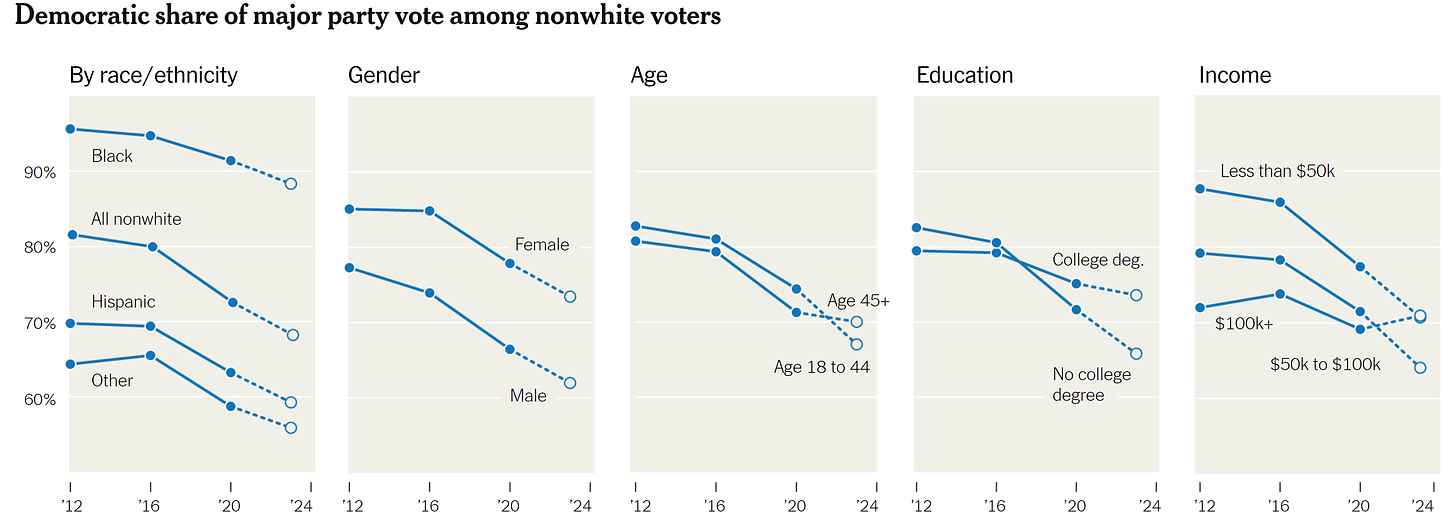I have written quite a bit about the Democrats’ emerging problem with nonwhite voters (for example, here, here and here), manifest in steadily declining margins among this demographic. Well, now it’s official.
Or at least strongly confirmed. The release of a characteristically thorough analysis by Nate Cohn in The New York Times provides abundant and persuasive evidence that this trend is real and shows no signs of going away. As Cohn notes, Biden leads Trump by a mere 53-28 percent margin among these voters in a merge of 2022-23 Times/Siena College polls. This is not only a sharp fall-off from Biden’s support in the 2020 election, but also from Biden’s and previous Democratic candidates’ support in analogous pre-election polls.
All this has left Democrats scratching their heads, given the nature of their opponent. Cohn points out some of the paradoxes that now confront Democrats:
Democrats have lost ground among nonwhite voters in almost every election over the last decade, even as racially charged fights over everything from a border wall to kneeling during the national anthem might have been expected to produce the exact opposite result. Weak support for Mr. Biden could easily manifest itself as low turnout—as it did in 2022—even if many young and less engaged voters ultimately do not vote for Mr. Trump.
Many of Mr. Biden’s vulnerabilities—like his age and inflation—could exacerbate the trend, as nonwhite voters tend to be younger and less affluent than white voters…Issues like abortion and threats to democracy may also do less to guard against additional losses among Black and Hispanic voters, who tend to be more conservative than white Biden voters. They may also do less to satisfy voters living paycheck to paycheck: Mr. Biden is underperforming most among nonwhite voters making less than $100,000 per year, at least temporarily erasing the century-old tendency for Democrats to fare better among lower-income than higher-income nonwhite voters.
The Times/Siena data suggests the emergence of a fairly clear education gap among nonwhite voters, as Mr. Biden loses ground among less affluent nonwhite voters and those without a degree. Overall, he retains a 61-23 lead among nonwhite college graduates, compared with a mere 49-31 lead among those without a four-year degree.
Clearly there’s a very real and very large problem here. Democrats may simply have misjudged what is most important to nonwhite voters, reflecting perhaps the increasing domination of their coalition by white college graduate voters, virtually the only demographic among whom the party has been doing steadily better. The agenda of white college graduates, particularly the progressives who support the party so fervently and fuel the party’s activist base, is less coterminous with that of nonwhite voters than Democrats seem to believe.
Reviewing recent data on the views of nonwhite voters makes it less mysterious why they can contain their enthusiasm for Biden.
1. A May Washington Post/ABC News poll asked, “Who do you think did a better job handling the economy (Donald Trump when he was president), or (Joe Biden during his presidency so far)?” Nonwhite respondents felt, by 48 to 41 percent, that Trump had done a better job on the economy than Biden is currently doing.
2. In an August Fox News poll, two-thirds of nonwhite voters rated their personal financial situation as only fair or poor and barely over a quarter (27 percent) said the Biden administration had made the economy better, compared to 42 percent who thought Biden had made the economy worse. Respectively, 46, 54 and 56 percent of nonwhite voters say gas prices, grocery prices and utility costs are a “major problem” for them and their family. Biden’s net approval (approval minus disapproval) among these voters is minus 25 on handling inflation, minus 22 on handling border security and minus 8 on handling the economy.
3. In a recent 6,000 respondent survey conducted by AEI’s Survey Center on American Life (SCAL) and the National Opinion Research Center (NORC), 57 percent of nonwhite voters say Biden has accomplished not that much or little or nothing during his time in office. About half consider the Democratic Party too extreme, think it bases its decisions more on politics than common sense and supports policies that interfere too much in people’s lives. Over two-fifths don’t see the Democrats as sharing their values. And over a third think Democrats look down on people like them, don’t value hard work and aren’t patriotic.
The Democratic Party has been all-in on the idea of “structural racism”—that idea that racism is “built into our society, including into its policies and institutions”, rather than coming “from individuals who hold racist views, not from our society and institutions.” In the SCAL/NORC survey, about half of nonwhite voters choose the latter view, that racism comes from individuals, not society. And two-thirds of these voters reject the idea of reducing police budgets in favor of social services, preferring instead to fully fund police budgets in the interest of public safety.
4. In The Liberal Patriot’s recent survey of American voters conducted by YouGov, most nonwhite voters believe the Democratic Party has moved too far left on both economic and cultural/social issues. On economic issues, 57 percent of these voters say Democrats have moved too far left. On cultural and social issues, 56 percent say the same.
As examples, only about a quarter of nonwhite voters identify with the standard Democratic position on transgender issues—that “states should protect all transgender youth by providing access to puberty blockers and transition surgeries if desired, and allowing them to participate fully in all activities and sports as the gender of their choice”. And only around a third support the standard Democratic position on climate and energy policy—that “We need a rapid green transition to end the use of fossil fuels and replace them with fully renewable energy sources.” The latter finding is intriguing because so much of Democrats’ industrial and economic policy is built around just this transition. But perhaps not surprising because climate change is just not a particularly important issue to the typical voter, including the typical nonwhite voter.
None of this means that nonwhite voters are now going to become a Republican constituency, despite these voters’ concerns about the Democrats and cross-pressures on issues. Hardly; Biden will likely carry these voters by a healthy margin in 2024. But it does mean that Democrats’ hold on these voters may well slip further in 2024, cutting Democrats’ margins dangerously among a group that has been the bedrock of Democrats’ electoral strategy.
That strategy has been based around the presumed effects of rising racial diversity. This demographic change is generally understood to be beneficial to the Democrats’ electoral fortunes (as John Judis and I argued in our 2002 book, The Emerging Democratic Majority). That’s a reasonable viewpoint based on a very simple idea: If voter groups favorable to the Democrats (nonwhites) are growing while unfavorable groups (whites) are declining, that should be good news for the Democrats. This is called a “mix effect”: a change in electoral margins attributable to the changing mix of voters.
These mix effects are what people typically have in mind when they think of the pro-Democratic effects of rising diversity. But mix effects, by definition, assume no shifts in voter preference: They are an all-else-equal concept, as we were careful to stress two decades ago. If voter preferences remain the same, then mix effects mean that the Democrats will come out ahead. That is a mathematical fact.
But voter preferences do not generally remain the same. Therein lies the reason why, in some cases, rising diversity has not produced the dividends for Democrats that many activists and advocates anticipated. And why it may not pan out for the Democrats in 2024, judging from the data reviewed above.
Democrats may have thought that they were on the right track in the wake of the “racial reckoning” of 2020. Surely if Democrats went all-in on social justice and racial “equity,” that would lock down the nonwhite vote. That was a chimera as a careful examination of actually-existing opinions and priorities among actually-existing nonwhite voters would have quickly revealed. Perhaps now that declining nonwhite support for the Democrats is “official”, that much-needed examination can take place.





